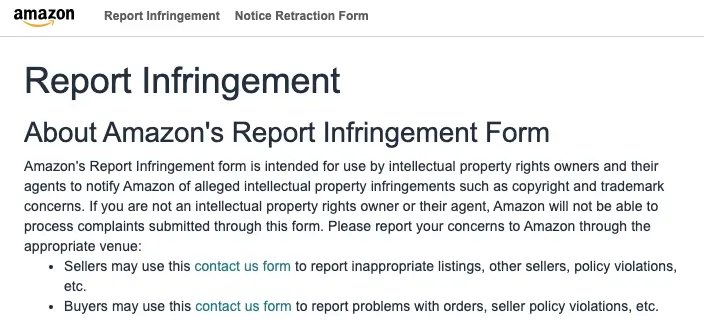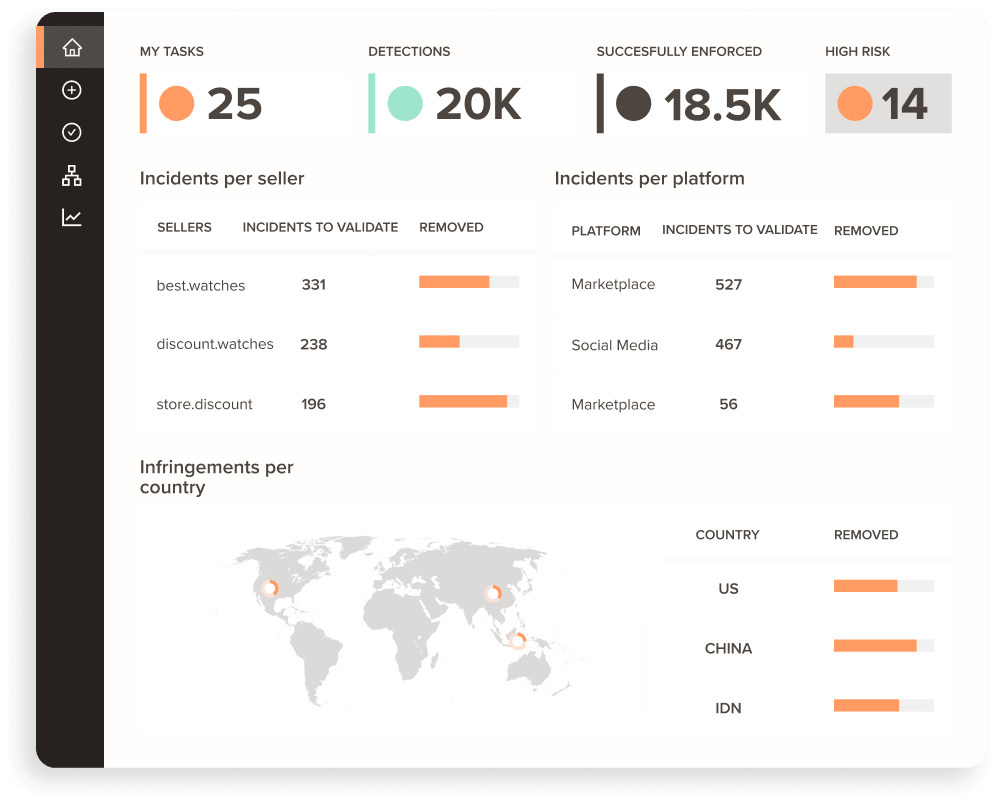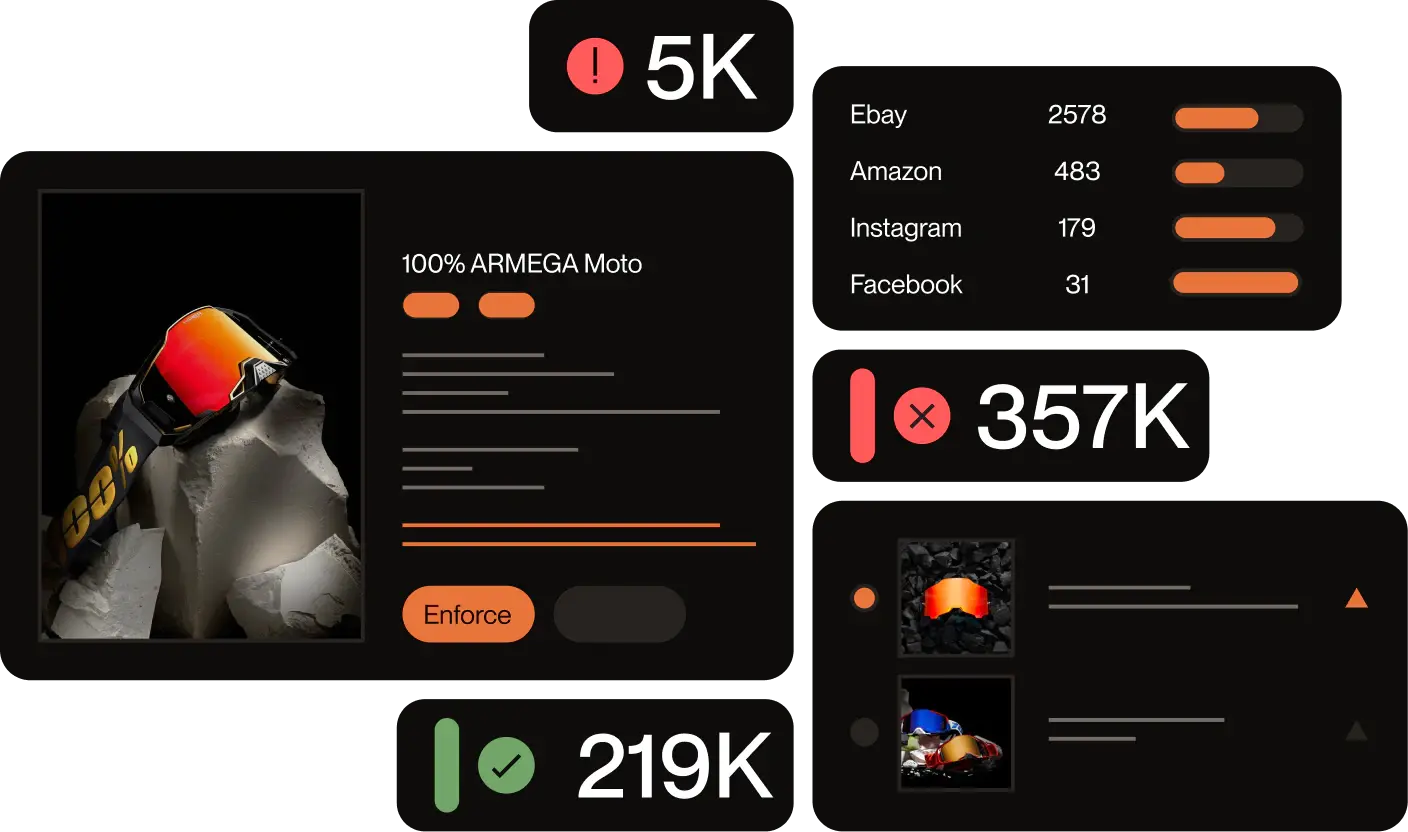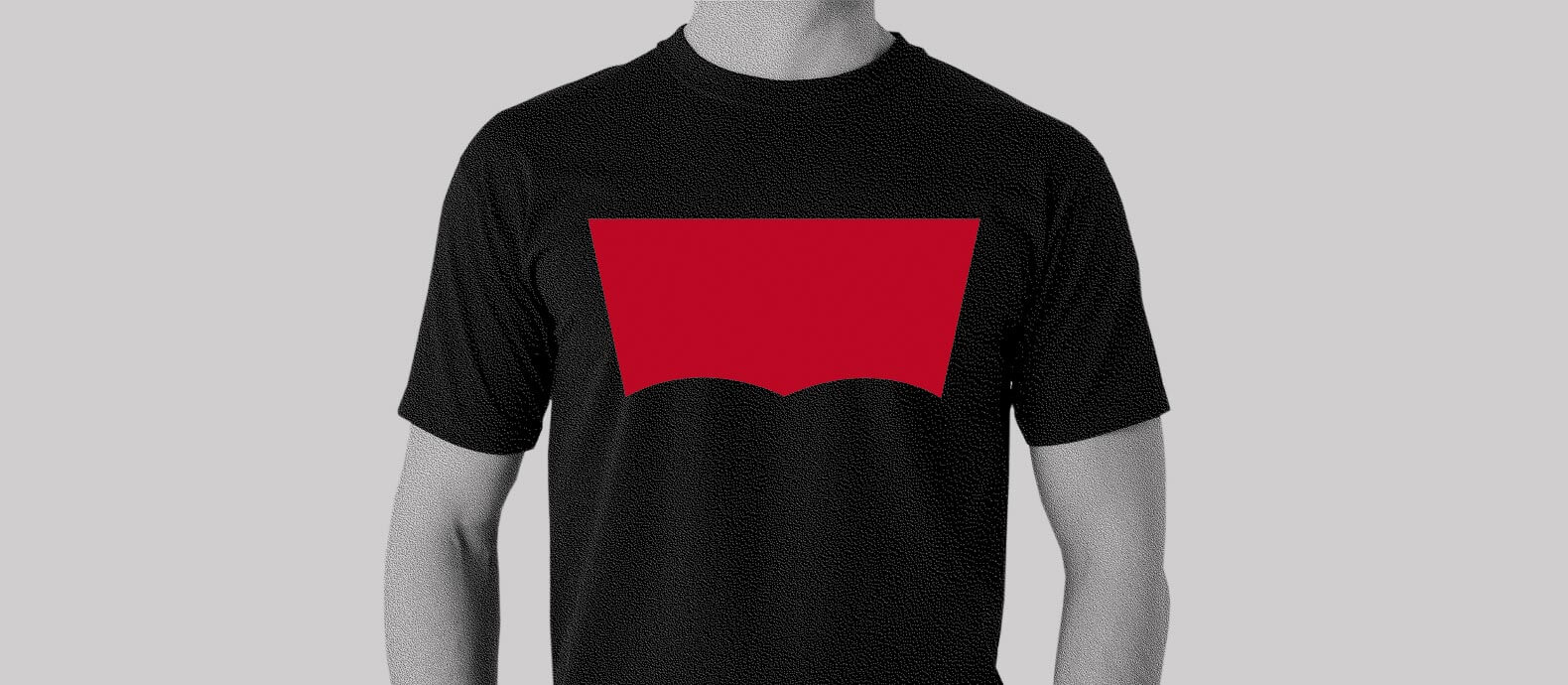Reporting fake merchandise shouldn’t be so complicated, but for many brands, it’s an uphill battle.
Each platform—whether it’s a marketplace, social media site, or search engine—has its own process, often buried in layers of bureaucracy. The result? Frustrating delays, incomplete removals, and counterfeit listings that continue to harm your brand.
Even when you gather the evidence and follow the steps, the odds can feel stacked against you. Platforms may demand more proof, provide vague timelines, or fail to act entirely. Meanwhile, the counterfeiters keep selling, undermining your efforts and damaging customer trust.
If you’re tired of navigating the maze of takedown requests, this guide is for you. We’ll walk you through the most efficient ways to report fake merchandise across different platforms, tackle common hurdles, and ensure your efforts lead to real results. Let’s simplify the process and help you reclaim your brand.
How to report fake merchandise
Step 1: Identify the reporting channel
Marketplaces
Due to their massive reach and global audience, marketplaces like Amazon, Shopee, and eBay are common targets for counterfeiters. Each marketplace has a specific process for reporting counterfeit goods, often calling for detailed evidence like product listings, purchase receipts, and proof of IP ownership. For example:
- Amazon has a “Report Infringement” tool within its Brand Registry dashboard, allowing users to submit detailed evidence for takedown requests.
- eBay requires users to submit violations through its Verified Rights Owner (VeRO) Program, where you can flag infringing items.

Tip: Familiarize yourself with the reporting policies of each marketplace before you submit your report. Missing even a small detail, like proof of trademark registration, can result in your report being denied. This is where tools like Red Points’ Brand Protection Software streamline the process, automating compliance with specific marketplace requirements and avoiding the constant back-and-forth.
Social media
Social media platforms like Instagram, TikTok, and Facebook have increasingly been targeted by counterfeiters who exploit their expansive reach and growing global audiences. These bad actors leverage paid ads and direct links to standalone websites, making it harder to trace their operations. The very elements that make these platforms appealing to legitimate users—widespread visibility and accessibility—are also what attract counterfeiters seeking to expand their reach.
Reporting counterfeit activity on social media often involves platform-specific tools, such as the “Report” function available for individual posts or accounts. However, counterfeiters frequently adapt, quickly creating new profiles or ads once their content is flagged.
Instagram allows users to report counterfeit products as “Intellectual Property Infringement” directly from a post. While the platform’s IP teams investigate flagged content, the process can be time-consuming, particularly when dealing with high volumes of reports. Similarly, Facebook and TikTok offer reporting processes, though the rising use of targeted fake ads presents additional challenges for enforcement.
Standalone websites
Counterfeiters often create standalone websites that mimic official brand sites, with fake logos, images, and even customer reviews. These sites are particularly dangerous as they operate independently of any larger platform, making enforcement a complex, manual task.
To report a standalone website:
- Identify the domain host using tools like WHOIS or ICANN lookup.
- Contact the hosting provider to report IP violations or fraudulent activity.
- Escalate the issue to local authorities or trade associations if necessary.
Step 2: Gather evidence
To make a strong case against counterfeit goods, you must start by collecting detailed evidence. This includes screenshots, documenting any product descriptions or listings where the item was found, and, if you made a test purchase, retaining receipts or transaction records. Quality evidence helps brand owners and authorities assess the legitimacy of your claim and strengthens the chance of it being enforced.
Tip: When you’re photographing the counterfeit item, capture any inconsistencies in logos, labels, or packaging. Counterfeiters often use misspelled brand names or distorted brand images to evade detection. Red Points’ data has shown that keyword misspellings and fake-known images (or images commonly used by counterfeiters) are increasingly common tactics. Visual proof of these discrepancies will be the key to getting counterfeit listings removed.
Step 3: Report to marketplaces
Counterfeiters often target multiple channels at the same time, so a multi-channel approach is the best way to guarantee effective enforcement.
Most major marketplaces have dedicated Intellectual Property (IP) rights platforms to streamline the reporting process for counterfeit items. These platforms are designed to ensure that legitimate claims are processed efficiently. Here are some examples of the requirements and processes:
- Amazon’s Brand Registry tool allows registered brand owners to submit infringement claims by uploading evidence, including proof of IP ownership and details of the counterfeit listing.
- eBay’s Verified Rights Owner (VeRO) program allows IP owners to report listings that violate their rights. This system is widely used by brands to combat counterfeit items listed for sale.
- Alibaba Group and its affiliated platforms (e.g. Taobao, AliExpress) offer an IPR Protection Platform where brands can register their intellectual property and report counterfeit listings directly. This simplifies enforcement across the Alibaba ecosystem.
Tip: Avoid the time-consuming back-and-forth with marketplaces by using a third-party tool like Red Points, which automates evidence collection, ensures compliance with marketplace requirements, and tracks takedowns in real time.
Leverage Red Points for brand protection
Fighting fake merchandise online can be overwhelming for brands, especially with counterfeiters constantly changing tactics. Red Points makes this easier by helping brands quickly find and report fake products. Using their Intellectual Property Rights (IPR) as the cornerstone, our platform scans marketplaces, social media, and websites to spot unauthorized use of logos, designs, or product images.
For example, Red Points uses advanced tools like AI-powered image recognition to compare fake product listings with official brand images. Natural Language Processing further enhances detection by analyzing patterns, keywords, and seller activity to detect counterfeit activity. This technology helps brands report issues faster and take action against fake merchandise more effectively.
One example of how Red Points has helped global brands effectively tackle counterfeiting and safeguard their online presence is Essity, a leader in hygiene and health products. With Red Points’ automated tool, Essity improved the protection of its brand across multiple regions and platforms, successfully removing over 80,000 instances of harmful or unauthorized use of its brand, and achieving a 94.4% success rate.
Step 4: File complaints with authorities
Involving legal authorities can strengthen your efforts against counterfeit merchandise, leading to more comprehensive enforcement. Here’s how to effectively file complaints with authorities and the benefits of doing so.
1. Identify the appropriate authority
Many countries have agencies dedicated to consumer protection and intellectual property (IP) enforcement. For instance, in the United States, the National Intellectual Property Rights Coordination Center (IPR Center) is a central point for reporting IP crimes. In the United Kingdom, the Police Intellectual Property Crime Unit (PIPCU) specializes in investigating serious IP crimes.
Depending on the jurisdiction, local police departments may also have specialized units for economic or cybercrimes that handle counterfeit cases. Engaging with them can lead to investigations and potential legal action against counterfeiters.
2. Prepare your documentation
Authorities need detailed evidence to initiate investigations. Make sure that you provide:
- Product information including detailed descriptions, model numbers, distinguishing features, and any discrepancies from the authentic products.
- Transaction records like invoices, receipts, and payment confirmations that can trace the purchase or sale of the counterfeit goods.
- Communications with the seller, such as emails or messages, that can establish the intent or knowledge of the counterfeit nature.
- High-quality photographs highlighting differences between the counterfeit and genuine products, focusing on logos, packaging, and quality.
3. Understand the benefits of reporting to authorities
While reporting to authorities requires effort, the advantages include:
- Deterrence, as legal actions can lead to significant penalties for counterfeiters which reduces the chances of future infringements.
- Comprehensive enforcement including raids, seizing of counterfeit goods, and taking down production and distribution networks, leading to major impact compared to individual marketplace takedowns.
- Legal recourse as a result of successful prosecutions, including compensation for damages and legal recognition of your IP rights.
4. Evaluate the effectiveness
The effectiveness of involving authorities varies depending on:
- Resource allocation, as some agencies may have limited resources, leading to longer response times.
- Jurisdictional challenges, as counterfeit operations often cover multiple countries, complicating enforcement due to different laws and cooperation levels.
- Success rates, for example, in 2023, U.S. authorities made arrests in connection with the largest seizure of counterfeit goods in U.S. history, valued at over $1 billion.
5. Collaborate with trade associations
Organizations like the International AntiCounterfeiting Coalition (IACC) offer resources and can connect you with the right authorities or resources. They provide guidance on best practices and may facilitate the cooperation between brands and enforcement agencies.
What happens after reporting?
Once a report is filed, the platform begins an investigation to verify the claim. This typically involves reviewing the evidence provided and deciding on whether the listing violates the platform’s IP policies. If the claim is confirmed, then the counterfeit listing is removed, and the seller’s account may face penalties, including suspension.
However, the process doesn’t always end there. Sellers often appeal takedown decisions, which can delay enforcement. For example:
- On eBay, sellers use the Seller Help tool to challenge reports, providing additional evidence or disputing claims.
- On Amazon, appeals often require a detailed Plan of Action, explaining steps to prevent future violations.
Reports can also be rejected outright, typically due to insufficient evidence, incorrect reporting procedures, or incorrect identification of legitimate items as counterfeits. These setbacks highlight how complex it is to enforce takedowns across platforms.
Red Points simplifies this process by automating evidence collection, filing reports, and ensuring compliance. With an average enforcement time of just three days (or hours, depending on the platform), Red Points minimizes the impact of counterfeits and reduces the complexity of managing appeals.
Fake merchandise evasion techniques trends you should know
Counterfeiters continue to evolve their tactics, bringing new trends that other scammers quickly pick up and copy. This makes it essential for brands to stay informed of the latest strategies used by sellers of counterfeit merchandise.
Keyword misspellings and “fake-known” images
A common tactic is altering brand names slightly (e.g., “Nkie” instead of “Nike”) to evade detection. Similarly, counterfeiters often use generic fake-known images which are specific images that counterfeiters frequently use to promote and sell fake products online. Red Points’ AI-driven Brand Protection Solution identifies these images by analyzing patterns and features commonly associated with counterfeit listings. Once an image is recognized as a “fake-known image,” the system can swiftly detect and flag counterfeit listings that use these images, even if they have been altered.
Growth of social media counterfeiting
With direct access to consumers, counterfeiters use social media to sell fake merchandise at an alarming rate. Red Points has observed a significant increase in infringements on platforms like Instagram and TikTok, where counterfeit accounts target followers directly. Outdoor footwear brand Keen was the victim of a social media advertising scam that led to an increase from 0 to 1,400 customer complaints in one day. They worked with Red Points to combat the issue and removed $35.6 million worth of counterfeit products.
Common reporting challenges
Unfortunately, dealing with counterfeit merchandise isn’t as simple as logging a report with the offending marketplace or social media channel. Reporting comes with a range of its own challenges. Many brands face obstacles like:
- Jurisdictional issues: Enforcement across borders can be difficult. Counterfeit listings in one country might not violate the laws in another, creating gaps in enforcement that counterfeiters take advantage of.
- Lack of awareness: Many consumers unknowingly purchase fake products, with 39% of counterfeit products purchased via ecommerce websites and social media, and Facebook being the most common platform (68%). Brands need to educate their audiences on how to identify authentic products and report counterfeit items.
- Time-consuming manual processes: Reporting counterfeit items manually can be resource-intensive. Brands that work with Red Points benefit from an automated approach, with tools that monitor and report infringements in real-time.
Red Points’ client Purple is a great example of how automated brand protection enables global reach and saves brands time. With Red Points’ capabilities, Purple managed to expand its brand internationally while keeping its online presence secure from counterfeit threats. We eliminated more than 24,000 infringements with a combined listing value of over $6 million.
What’s next?
Counterfeit merchandise continues to pose a serious threat to brands, impacting their reputation, revenue, and customer trust. Addressing the issue calls for a proactive approach, from gathering evidence and identifying the best reporting channels to utilizing automated brand protection solutions. Red Points stands out in this field with industry-leading technology, and a proven track record, offering customized solutions for brands across the world.
If your brand is facing the challenges of counterfeiting, request a demo of Red Points Brand Protection Software today.








